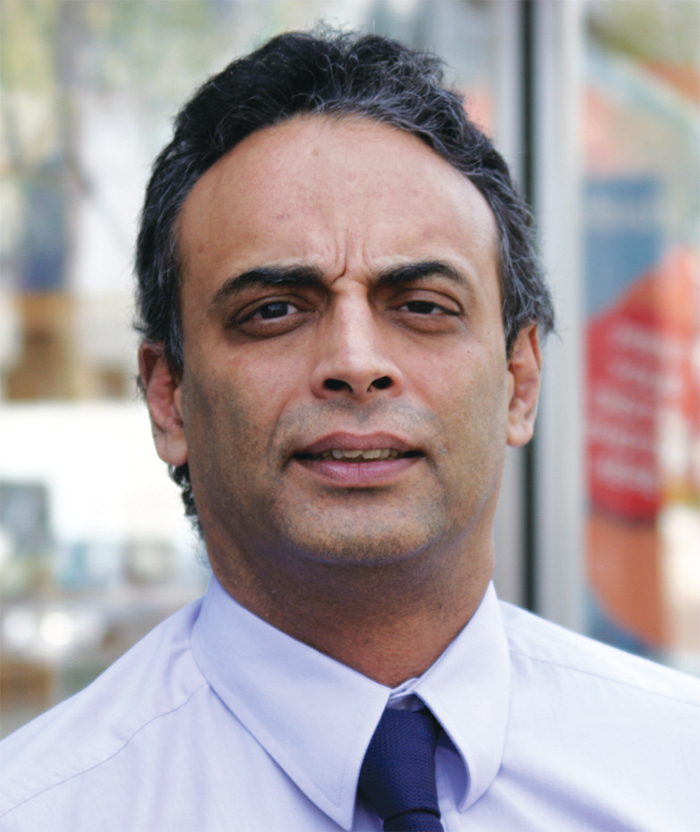Are you ready for change and innovation?
In Interviews
Follow this topic
Bookmark
Record learning outcomes
As funding cuts look likely for England’s community pharmacies, what opportunities might there be in the proposed Pharmacy Integration Fund? P3 finds out more from independent contractor and Royal Pharmaceutical Society president Ash Soni

Innovation in the NHS is currently being driven in a range of “vanguard” sites, where new models of care, and new ways of integrated working are being trialled (See P3’s article Pharmacy in the vanguard). Community pharmacy is involved in only a few of the projects so far, but England will soon have access to it’s own source of funding for the development of new ideas – the Pharmacy Integration Fund (PhiF). It’s controversial, because it was announced in December along with significant pharmacy funding cuts. But are there positives to be seen in the proposals, P3 asks RPS president Ash Soni?
The letter from Keith Ridge and Will Cavendish in December, that announced funding cuts for community pharmacy in England, has most certainly created a “trigger for change,” says Mr Soni. The proposals, being consulted on until 24 March, want to see pharmacist skills being applied “at the heart of the NHS”, and efficiencies and new systems for patient care and medicines supply. Integration of community pharmacy into the NHS will be the focus of the new Integration Fund.
“This will be the primary means of driving transformation of the pharmacy sector to embed medicines optimisation and the practice of clinical pharmacy in primary care, bringing clear benefits to patients and to the public,” said Dr Ridge in January, describing the purpose of the fund. Other than this statement, very few facts have yet emerged publicly on how the scheme might work.
What the Pharmacy Integration Fund will do
Government has said that the size of the Integration Fund is £20 million in year one, rising by £20 million a year. This is an amount of money to take notice of, says Mr Soni. The fund is £20 million this year, “but that’s £20 million in six months,” he points out. “So that’s £100 million in year five, and the total value of the pot is £300 million over five years. In some ways, looked at over time, this figure may be larger than what’s being taken out [through the 6 per cent cut].”
The plan is that the PhIF money will be awarded to promote change and innovation. “Change, as a process, is very hard, and that’s why they’ve created the Pharmacy Integration Fund. Community pharmacy has really struggled to access transformation funds in the wider system. So this is pharmacy’s version of transformation funds, if you like,” he says.
While it’s not at all clear how many pharmacies might receive money from the fund, or the criteria for applying for and being awarded it, it could be worth bidding for, he suggests. “Part of what they’re thinking about now, is how to use that money. It’s not a huge amount, but if you think about it, say it was [awarded to] 1,000 pharmacies, that’s £20,000 a pharmacy, which is not insignificant at all.” However, there are no plans at present as to how many pharmacies might benefit from the additional funding or how it might be available.
Separating the funds from the pharmacy contract has been a considered move, he said. “I think one thing they [DH] are absolutely clear about is that unless there’s a very good case made, it [the funding] will not go into contract. Once you put it into the contract, then you have to give it to everybody. If you want to create transformation, you target it at those that can demonstrate change, which then allows that change to spread.”
Could you apply?
The PhIF gives community pharmacy a new opportunity to “create change in the system”, say Mr Soni. “We need people to see this as an opportunity to create our own new models of care.” He says that he’s been very interested to find out if the integration funding would be the total of the transformation money available. Could community pharmacy potentially be successful in securing more funds over and above this specified amount in the future? He has asked the question, he said, and did have a reply – but there are no guarantees.
“If you had a whole series of really fantastic bids, and the total costs of those bids was greater than £20 million, would they find more money? From what we understand, there are no absolutes, but the conversation was that if that was the case then we’d see what we could find. So there could be more funding, but it wouldn’t then be from the Pharmacy Integration Fund, it would be other transformation money.”
It’s clear that community pharmacy would have to work hard to impress to secure any additional funding, even if it exists. Change is firmly on the agenda across England’s pharmacies.
As part of the consultation, thought is being put into considering how the fund would work, and how pharmacies might access it. “The challenge is, how do you make sure the right people get the money?, he says. “What is the process going to be to access that integration fund money? They will need to be clear about this,” says Mr Soni.
It’s important that the process is transparent and fair, and that it does achieve it’s objective of promoting change. Smaller pharmacies have as much potential to contribute as larger chains, for example, but are likely to have less expertise in bidding processes. “When you think about it, it can’t just be about the quality of the bid [as a document], because smaller pharmacies will miss out to the multiples. If I’m up against a multiple with a team that writes the bids, then I will lose hands down every time. If they write lots of proposals, they will be good at writing them in the way that hits the right trigger points.”
Existing innovators and new teams will want to be encouraged to get involved. “Again, it would be wrong is if the funding was exclusively awarded to pharmacies already doing some great stuff - you’re already doing it, you’re creating integration – and just focus on the ones who haven’t bothered so far. You have to value what’s there already too.” When plans are in place, there will be opportunities for proactive pharmacy teams to get involved.
“There is an opportunity. Now we just have to figure out how to do some of this. And that I think that’s the real problem. No one has a masterplan at all yet – apart from that we see a very different environment for pharmacy and pharmacists to be operating in, in five years’ time, which is much more about medicines optimisation and so on.” And with transformation on the DH agenda, it will pay to be open-minded on the subject.
“So the trigger is there for change. There will be a group of people who are capable of change, but also those for whom change will have to be almost forced on them and then some people who will never change. The ones who never change are probably those who are at the greatest risk of closing or will need to rely on their financial clout to survive,” he warns.
Community pharmacies should also be actively looking at opportunities to bid for funds from CCG and public health routes in the future, he suggests, although changes could be made to assist pharmacy in getting involved. “If this is going to work, they’ve got to allow all of us the same opportunity, and to allow pharmacy to bid collectively. So what you get primary care to bid for money as a whole – you bid as a primary community care family for transformation, and the challenge is then to make the money fair and equitable.” The costs that community pharmacy incurs when delivering a commissioned service also need to be taken into account in the future, he suggests.
“In December’s letter Keith Ridge said that the average pharmacy receives £220,000. That’s the revenue that comes in, but out of that I have to pay my staff, my rates, my rent – all of the costs come out of that money. So for bids in the future, we have to be able to say there is a cost that has to be built in for pharmacy, recognising the costs that are attached.”
What happens next?
The second phase of consultation with the Department of Health closes on 24th March. “Then they have to lay the regulations. The money will come out in October, but the regulations for all of the elements of this, including the Pharmacy Access Fund, will have to be completed in April. The only thing that doesn’t have to be done then is the Pharmacy Integration Fund, because it’s not in the contract.”
Mr Soni is hopeful that the Pharmacy Integration Fund will bring interesting developments for community pharmacy. “The hope is that the ones who have access to the additional money are able to demonstrate change, at pace, which then allows others to do the same and be part of the wider NHS transformation. That’s part of the challenge ahead.”
Change, as a process, is very hard, and that’s why they’ve created the Pharmacy Integration Fund
 Ash Soni on...
Ash Soni on...
Is there a case for a form of QOF for pharmacy?
“In general practice, they use the QOF [Quality and Outcomes Framework] system as a reward system for quality, although that has its own issues and its own problems. We have talked about a pharmacy based QOF in the past, if you go back to the RPS Call to Action. That very much talked about this new world of pharmacy, the prescribing pharmacist, managing long term conditions, transformational care and integrating with other health professionals.”
Closures in clusters…?
“We’ve got to be careful about over clustering to reduce numbers [that could risk local monopolies]. What wouldn’t be good for the market if you end up with single pharmacies in an area. How do I measure and push quality within those? How do we stimulate the market or allow new innovation into the marketplace?”
Dispensing doctors…
“One thing not in the consultation, which is very worrying, is that dispensing doctors are “out of scope”. Why? Are they saying that they’re prepared to accept dispensing doctors will continue to be paid more, and therefore will be a more expensive model of delivery? We do need to make a noise about this.”
Roles not locations…
“It worries me that we’re talking about pharmacists in GP practices; pharmacists in care homes; pharmacists in NHS 111 – and people are saying they’re different, but they’re not. They’re all pharmacists who are trying to work collectively to deliver the best care for patients. We see them more as roles.”
